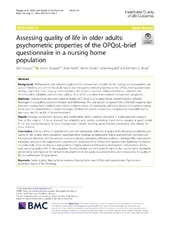| dc.contributor.author | Haugan, Gørill | en_US |
| dc.contributor.author | Drageset, Jorunn | en_US |
| dc.contributor.author | Andre, Beate | en_US |
| dc.contributor.author | Kukulu, Kamile | en_US |
| dc.contributor.author | Mugisha, James | en_US |
| dc.contributor.author | Utvær, Britt Karin Støen | en_US |
| dc.date.accessioned | 2020-08-14T12:53:21Z | |
| dc.date.available | 2020-08-14T12:53:21Z | |
| dc.date.issued | 2020-01-02 | |
| dc.Published | Haugan G, Drageset J, Andre B, Kukulu K, Mugisha J, Utvær BKS. Assessing quality of life in older adults: psychometric properties of the OPQoL-brief questionnaire in a nursing home population. Health and Quality of Life Outcomes. 2020;18:1 | eng |
| dc.identifier.issn | 1477-7525 | |
| dc.identifier.uri | https://hdl.handle.net/1956/23788 | |
| dc.description.abstract | Background: Well-adapted and validated quality-of-life measurement models for the nursing home population are scarce. Therefore, the aim of this study was to test the psychometrical properties of the OPQoL-brief questionnaire among cognitively intact nursing home residents. The research question addressed evidence related to the dimensionality, reliability and construct validity, all of which considered interrelated measurement properties. Methods: Cross-sectional data were collected during 2017–2018, in 27 nursing homes representing four different Norwegian municipalities, located in Western and Mid-Norway. The total sample comprised 188 of 204 (92% response rate) long-term nursing home residents who met the inclusion criteria: (1) municipality authority’s decision of long-term nursing home care; (2) residential time 3 months or longer; (3) informed consent competency recognized by responsible doctor and nurse; and (4) capable of being interviewed. Results: Principal component analysis and confirmative factor analyses indicated a unidimensional solution. Five of the original 13 items showed low reliability and validity; excluding these items revealed a good model fit for the one-dimensional 8-items measurement model, showing good internal consistency and validity for these 8 items. Conclusion: Five out of the 13 original items were not high-quality indicators of quality-of-life showing low reliability and validity in this nursing home population. Significant factor loadings, goodness-of-fit indices and significant correlations in the expected directions with the selected constructs (anxiety, depression, self-transcendence, meaning-in-life, nurse-patient interaction, and joy-of-life) supported the psychometric properties of the OPQoL-brief questionnaire. Exploring the essence of quality-of-life when residing in a nursing home is highly warranted, followed by development and validation of new tools assessing quality-of-life in this population. Such knowledge and well-adapted scales for the nursing home population are beneficial and important for the further development of care quality in nursing homes, and consequently for quality-of-life and wellbeing in this population. | en_US |
| dc.language.iso | eng | eng |
| dc.publisher | BioMed Central | eng |
| dc.rights | Attribution CC BY | eng |
| dc.rights.uri | http://creativecommons.org/licenses/by/4.0/ | eng |
| dc.title | Assessing quality of life in older adults: psychometric properties of the OPQoL-brief questionnaire in a nursing home population | en_US |
| dc.type | Peer reviewed | |
| dc.type | Journal article | |
| dc.date.updated | 2020-02-13T12:33:18Z | |
| dc.description.version | publishedVersion | en_US |
| dc.rights.holder | Copyright 2019 The Authors | |
| dc.identifier.doi | https://doi.org/10.1186/s12955-019-1245-3 | |
| dc.identifier.cristin | 1747322 | |
| dc.source.journal | Health and Quality of Life Outcomes | |

